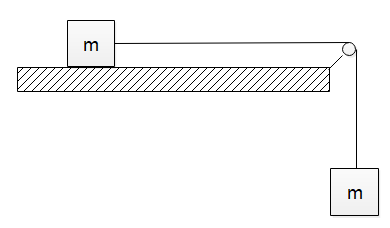
Figure shows two blocks each of masses $ m $ connected by a string passing over a pulley. The horizontal table is smooth. The pulley has a radius $ r $ and moment of inertia $ I $ Find the acceleration of the hanging mass

A) $ a = \dfrac{{mg}}{{2m + \dfrac{1}{{{r^2}}}}} $
B) $ a = \dfrac{{mg}}{{m + \dfrac{1}{{{r^2}}}}} $
C) $ a = \dfrac{{2mg}}{{2m + \dfrac{1}{{{r^2}}}}} $
D) $ a = \dfrac{{mg}}{{m + \dfrac{1}{{{r^2}}}}} $

Answer
551.4k+ views
Hint: In this solution, we will first calculate the tension in the string on the left side and below the pulley. Then we will use the relation of torque and angular acceleration to determine the acceleration of the hanging mass.
Formula used: In this solution, we will use the following formula:
Torque of the pulley: $ \tau = F.r = I.\alpha $ where $ F $ is the force on the pulley, $ r $ is the radius of the pulley, $ I $ is the moment of inertia of the rod, and $ \alpha $ is the angular acceleration of the pulley.
Complete step by step answer
In the diagram given to us, the block on the flat surface will move to the right since there is no friction and the string will rotate over the pulley.
Let the tension in the string on the left of the pulley will be $ {T_1} $ and the tension in the string below the pulley be $ {T_2} $ and the acceleration of both the masses be $ a $ . The equation of motion of the top mass will be
$ {T_1} = ma $
And for the lower mass which is falling down will be
$ Mg - {T_2} = Ma $
Hence the force acting on the pulley will be
$ F = {T_2} - {T_1} $
The torque acting on the pulley will be determined from $ \tau = F.r = I.\alpha $ as
$ ({T_2} - {T_1})r = I\alpha $
Now, as $ \alpha = a/r $ , we have
$ ({T_2} - {T_1})r = \dfrac{{Ia}}{r} $
Substituting the values of $ {T_1} $ and $ {T_2} $ , we get
$ mg - 2ma = \dfrac{{Ia}}{{{r^2}}} $
Solving for $ a $ , we get
$ a = \dfrac{{mg}}{{2m + \dfrac{I}{{{r^2}}}}} $ which corresponds to option (A).
Note
Here we must realize that the acceleration of the two blocks will be the same since they are connected by a string. Also, the tension on two sides of the pulley will be unequal since the string will be rotating on the pulley without slipping.
Formula used: In this solution, we will use the following formula:
Torque of the pulley: $ \tau = F.r = I.\alpha $ where $ F $ is the force on the pulley, $ r $ is the radius of the pulley, $ I $ is the moment of inertia of the rod, and $ \alpha $ is the angular acceleration of the pulley.
Complete step by step answer
In the diagram given to us, the block on the flat surface will move to the right since there is no friction and the string will rotate over the pulley.
Let the tension in the string on the left of the pulley will be $ {T_1} $ and the tension in the string below the pulley be $ {T_2} $ and the acceleration of both the masses be $ a $ . The equation of motion of the top mass will be
$ {T_1} = ma $
And for the lower mass which is falling down will be
$ Mg - {T_2} = Ma $
Hence the force acting on the pulley will be
$ F = {T_2} - {T_1} $
The torque acting on the pulley will be determined from $ \tau = F.r = I.\alpha $ as
$ ({T_2} - {T_1})r = I\alpha $
Now, as $ \alpha = a/r $ , we have
$ ({T_2} - {T_1})r = \dfrac{{Ia}}{r} $
Substituting the values of $ {T_1} $ and $ {T_2} $ , we get
$ mg - 2ma = \dfrac{{Ia}}{{{r^2}}} $
Solving for $ a $ , we get
$ a = \dfrac{{mg}}{{2m + \dfrac{I}{{{r^2}}}}} $ which corresponds to option (A).
Note
Here we must realize that the acceleration of the two blocks will be the same since they are connected by a string. Also, the tension on two sides of the pulley will be unequal since the string will be rotating on the pulley without slipping.
Recently Updated Pages
Why are manures considered better than fertilizers class 11 biology CBSE

Find the coordinates of the midpoint of the line segment class 11 maths CBSE

Distinguish between static friction limiting friction class 11 physics CBSE

The Chairman of the constituent Assembly was A Jawaharlal class 11 social science CBSE

The first National Commission on Labour NCL submitted class 11 social science CBSE

Number of all subshell of n + l 7 is A 4 B 5 C 6 D class 11 chemistry CBSE

Trending doubts
What is meant by exothermic and endothermic reactions class 11 chemistry CBSE

10 examples of friction in our daily life

One Metric ton is equal to kg A 10000 B 1000 C 100 class 11 physics CBSE

1 Quintal is equal to a 110 kg b 10 kg c 100kg d 1000 class 11 physics CBSE

Difference Between Prokaryotic Cells and Eukaryotic Cells

What are Quantum numbers Explain the quantum number class 11 chemistry CBSE




